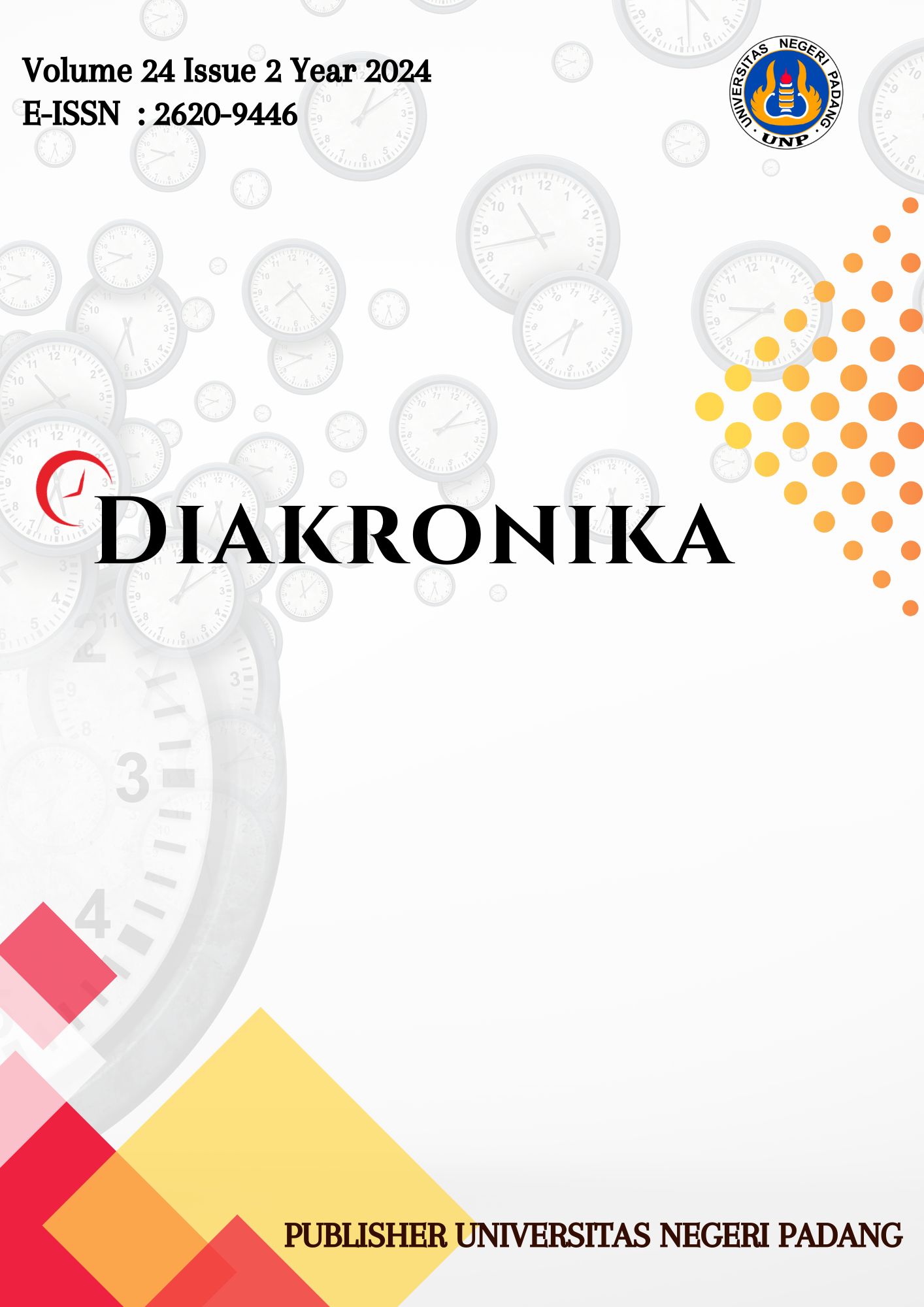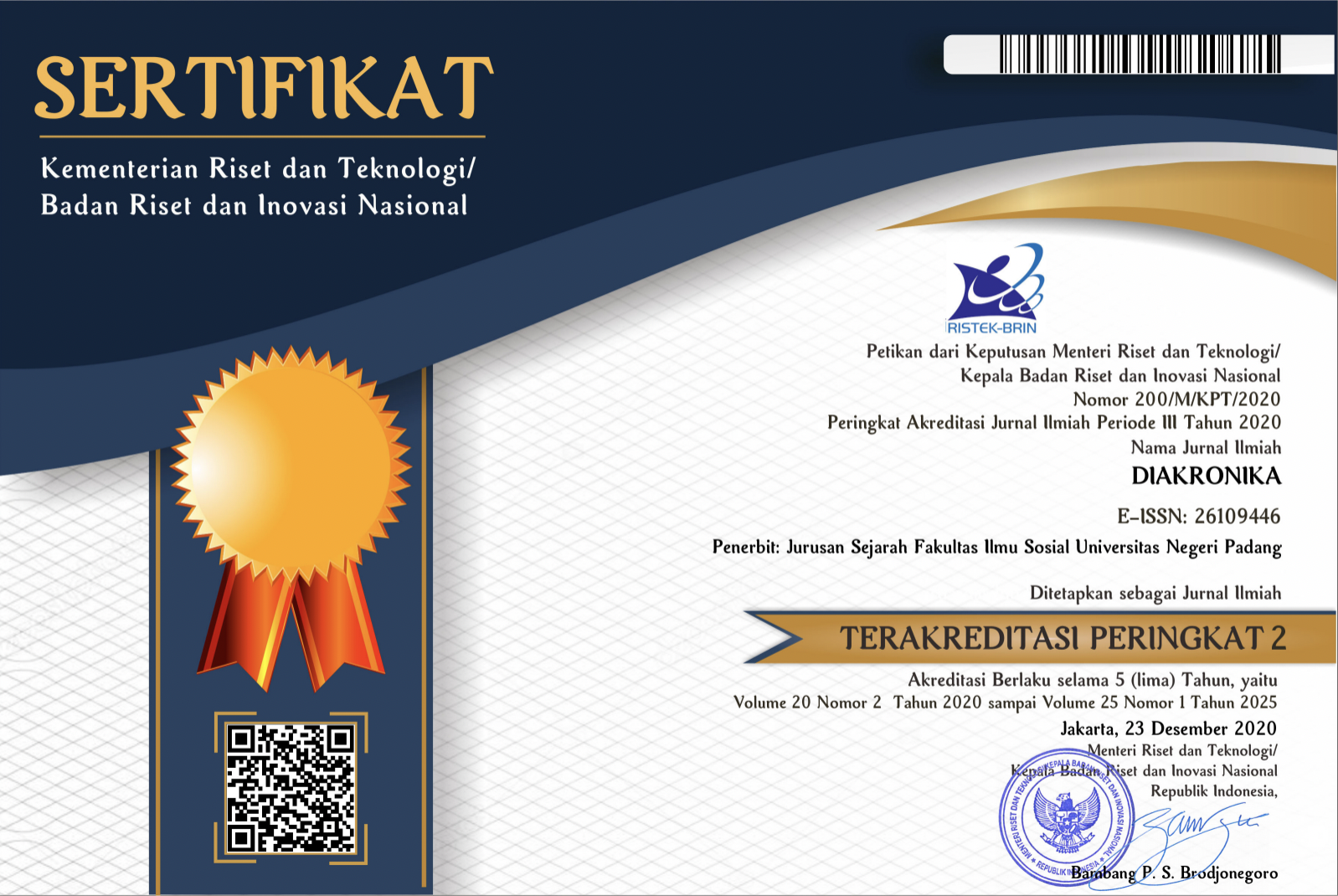The Idea of Nationalism in Indonesian History Textbooks (1975-2013)
Abstract
Nationalism plays an essential role in nation-building and national integration in Indonesia. This research aims to scrutinize the change and the continuity of the idea of nationalism in Indonesia through discourse historical analysis of the Indonesian history textbooks from the New Order to the Post-reformation era. The question addressed in this research: Has Indonesian society ‘reimagined’ or ‘recalibrated’ the conception of nationalism along with the political transitions and transnational problems? Qualitative methods with the Discourse Historical Analysis approach were used to examine the history textbooks. Textbook analysis showed that the political transition from the Guided Democracy era to the New Order era in 1966 or the fall of the New Order era in 1998 did not significantly change the idea of nationalism. The primeval idea of nationalism remains the basic foundation of nationalistic discourse in history textbooks. Every political regime tends to impart or attach its political interest to nationalism. As a result, the primeval ideas of nationalism, developmental nationalism, and modern nationalism are intermingled. It tends to create a continuation and dynamic rather than changes in nationalism. As a result, the idea of nationalism in Indonesia, as represented in history textbooks, tends to be a political project rather than a collective one.
Downloads
References
Ahonen, S. (2001). Politics of identity through history curriculum: Narratives of the past for social exclusion - or inclusion? Journal of Curriculum Studies, 33:2, 179–194. https://doi.org/10.1080/00220270010011202
Ali, M. (1965). Some Problem in Indonesian Historiography (Soedjatmoko (Ed.) (ed.)). Cornell University Press.
Anderson, B. (2006). Imagined communities: Reflections on the origin and spread of nationalism. Verso books.
Anderson, B. (2015). Papua’s insecurity: state failure in the Indonesian periphery. East-West Center.
Anderson, B. R. G. (1999). Indonesian nationalism today and in the future. 1–11.
Ankersmit, F. R. (1983). Narrative logic: A semantic analysis of the historian’s language. Nijhoff, 7.
Asnan, G. (2011). Regionalisme, Historiografi, dan Pemetaan Wilayah: Sumatera Barat Tahun 1950-an” in van Bammelen, S and Raben, R. (2011). Antara Daerah dan Negara: Indonesia tahun 1950-an, Pembongkaran Narasi besar Integrasi Bangsa. Yayasan Pustaka Obor Indonesia & KITLV-Jakarta.
Aspinall, E., & Berger, M. T. (2001). The break-up of Indonesia? Nationalisms after decolonization and the limits of the nation-state in post-Cold War Southeast Asia. Third World Quarterly, 22(6), 1003–1024.
Badrika, I. . (1994). Sejarah Nasional Indonesia dan Umum untuk kelas 3 for Curriculum. Erlangga.
Barker, J. (2008). Beyond Bandung: developmental nationalism and (multi) cultural nationalism in Indonesia. Third World Quarterly, 29(3), 521–540.
Bell, I., Feith, H., & Hatley, R. (1986). ). The West Papuan Challenge to Indonesian Authority in Irian Jaya: Old Problems, New Possibilities. Asian Survey, 26(5), 539–556.
Boorman, J., & Hume, A. R. (2003). Life with the IMF: Indonesia’s Choices for the Future.
Bourchier, D. M. (2019). Two Decades of Ideological Contestation in Indonesia: From Democratic Cosmopolitanism to Religious Nationalism. Journal of Contemporary Asia, 49(5), 713–733.
Budiatri, A. . (2020). Revising the Special Autonomy Law for Papua: Challenges and Possibilities. ISEAS Perspective, 56 (Juni), 1–10.
Calhoun, C. (1993). Nationalism and ethnicity. Annual Review of Sociology, 19(1), 211–239.
Cisar, O. (2000). Developmentalists and Nationalists: On the Transformations in Eastern Europe. Stredoevropske Politicke Studie, 2(4).
Dalrymple, R. (1998). Indonesia and the IMF: the evolving consequences of a reforming mission. Australian Journal of International Affairs, 52(3), 233–239.
Djono, D., & Joebagio, H. (2019). Narration and Discourse of Bhinneka Tunggal Ika in Indonesian Revised History Textbook: A History Didactics Approach. Paramita: Historical Studies Journal, 29(1), 18–27.
Djono, D., Joebagio, H., & Abidin, N. F. (2020). Gerak Sejarah Integratif-Multidimensional: Warisan Sartono Kartodirdjo Bagi Filosofi Pendidikan Sejarah Menuju Society 5.0. Criksetra: Jurnal Pendidikan Sejarah, 9(1), 32–46.
Drake, C. (2019). National integration in Indonesia: Patterns and policies. University of Hawaii Press.
Eddyono, S. (2020). Competing Nationalism in Post-New Order Indonesia. Nationalism and Ethnic Politics, 26(4).
Feith, H. (2006). The decline of constitutional democracy in Indonesia. Equinox Publishing.
Gellert, P. K. (2010). Extractive regimes: toward a better understanding of Indonesian development. Rural Sociology, 75(1), 28–57.
Gellert, P. K. (2015). Optimism and education: The new ideology of development in Indonesia. Journal of Contemporary Asia, 45(3), 371–393.
Islam, I. (1984). Socio-Economic Progress in Indonesia under the New Order: An Assessment. Southeast Asian Affairs, 137–150.
Kahin, A. (1999). Rebellion to integration: West Sumatra and the Indonesian polity, 1926-1998. Amster.
Karima, E. M., Nurlizawati, N., Firza, F., Abidin, N. F., & Ibrahim, Y. (2024). Reducing Cognitive Bias of Pre-Service History Teachers through Augmented Reality. JOIV: International Journal on Informatics Visualization, 8(1), 520-525. dam University Press.
Kartodirdjo, S. (187 C.E.). Pengantar sejarah Indonesia baru, 1500-1900: Dari emporium sampai imperium (Vol. 1). Gramedia.
Kartodirdjo, S. (1966). The peasants’ revolt of Banten in 1888 (p. 392). Brill.
Kaup, B. Z., & Gellert, P. K. (2017). Cycles of resource nationalism: Hegemonic struggle and the incorporation of Bolivia and Indonesia. International Journal of Comparative Sociology, 58(4), 275–303.
Kawamura, K. (2008). Indonesia’s Development Policy in Historical Perspective. https://doi.org/http://dx.doi.org/10.2139/ssrn.1742679
Ki Hadjar Dewantara. (1952). Dari kebangkitan nasional sampai proklamasi kemerdekaan. Endang.
Kingston, J. (2016). Nationalism in Asia: A history since 1945. John Wiley & Sons.
Kirsch, S. (2002). Rumour and other narratives of political violence in West Papua. Critique of Anthropology. Critique of Anthropology, 22(1), 53–79.
Kohn, H. (1965). Nationalism: Its Meaning and History. Robert E. Krieger Publishing Company.
Leifer, M. (2002). The changing temper of Indonesian nationalism. In Routledge (pp. 163–179).
Liow, J. C. (2016). Religion and nationalism in Southeast Asia. Cambridge University Press.
McGregor, K. E. (2007). History in uniform: Military ideology and the construction of Indonesia’s past. NUS Press.
Menchik, J. (2014). Productive intolerance: Godly nationalism in Indonesia. Comparative Studies in Society and History, 56(3), 591–621.
Moedjanto, G., Sunarti, N., Kristanto, Haryono, A. and Padi, A. . (1992). Sejarah Nasional Indonesia untuk SMA dan Sekolah yang Sederajat. Grasindo.
Mulyana, A. (2021). Narratives of Nationalism in Indonesia and Malaysia’s History Textbooks. Paramita: Historical Studies Journal, 31(2).
Murphy, A. M. (1999). Indonesia and globalization. Asian Perspective, 229–259.
Nagazumi, A. (1972). The dawn of Indonesian nationalism: The early years of the Budi Utomo, 1908-1918 (Vol. 10). In Institute of Developing Economies.
Notosusanto, N. & Basri, Y. (1992). Sejarah Nasional Indonesia untuk SMA, Jilid 3 or Indonesian National History for Senior High School, Volume 3. In The Department of Education and Culture of Republic of Indonesia.
Notosusanto, N. (1965). Problems in the Study and Teaching of National History in Indonesia. Journal of Southeast Asian History, 6(1), 1–16.
Purwanta, H. (2017). Militaristic Discourse in Secondary Education History Textbooks during and after the Soeharto Era. Journal of Educational Media, Memory, and Society, 9(1), 36–57.
Purwanto, B. (2001). Historisme baru dan kesadaran dekonstruktif: kajian kritis terhadap historiografi Indonesiasentris. Humaniora, 13(1), 29–44.
Reisigl, M. (2017). The discourse-historical approach. In The Routledge Handbook of critical discourse studies (pp. 44-59). Routledge.
Ricklefs, M. C. (2008). A History of Modern Indonesia since c. 1200. In Macmillan International Higher Education.
Robison, R., & Rosser, A. (1988). Contesting reform: Indonesia’s new order and the IMF. World Development, 26(8), 1593–1609.
Ruhyanto, A. (2016). The Perils of Prosperity Approach in Papua. Peace Review, 28(4), 490–498.
Russen, J. (1994). Historisches Lernen. Bohlau.
Sardiman A.M. and Lestariningsih, A. . (2014). Sejarah Indonesia kelas XI semester 1 dan semester 2 for Curriculum 2013. In The Ministry of Education and Culture.
Shiraishi, T. (1990). An age in motion: Popular Radicalism in Java, 1912-1926.
Soekarno. (1929). Indonesia Menggugat.
Soekarno. (1952). Be True to Your Source: President’s speech. Indonesian Affairs, 2(2).
Stapel, F. W. (1939). Geschiedenis van Nederlandsch-Indie III.
Suryadinata, L. (2000). Nation-building and nation-destroying: The challenge of globalization in Indonesia. Nationalism and Globalization: East and West, 38–70.
Tarunasena. (2009). Sejarah MA/MA untuk kelas XI Semester 1 dan 2 Program Ilmu Pengetahuan Sosial for Curriculum KTSP. The Department of National Education.
Taubert, A. (1991). Liberalization, Co-operatives, and Ekonomi Pancasila. Contemporary Southeast Asia, 347–359.
Van Miert, H., Satiman, S., & Sardjono-Soesman, M. F. (2003). Dengan semangat berkobar: nasionalisme dan gerakan pemuda di Indonesia, 1918-1930. KITLV.
Wardaya. (2009). Cakrawala Sejarah untuk SMA/MA Kelas XI (Program IPS). The Department of National Education.
Waridah, S. Sukardi, J., and Sunarto, P. (2003). Sejarah Nasional dan Umum 3, untuk SMU kelas 3 for revised Curriculum 1994. Bumi Aksara.
White, H. (1990). The content of the form: Narrative discourse and historical representation. JHU Press.





